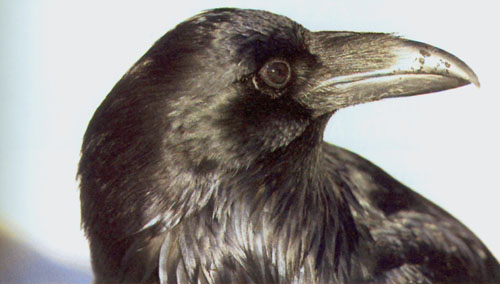IN MEDITATION PRACTICE, as in the garden, often the best learning happens at the edge of what you know, where the sorceress hills at the back of your brain go stone dark and you push through onto new ground. “Not wholly in the busy world, nor quite beyond it,” observed the poet Alfred, Lord Tennyson of the garden. This is the landscape I happened upon this winter, standing in the last Green Gulch field before the ocean, when a flock of ravens dismantled my notion of what it takes to make a garden.
For the last decade this abandoned, windswept field has served as the Zen Center compost yard. Truckloads of brush are stacked down there, slash standing next to mountains of noxious weeds, left to molder and decompose in the ocean wind. This spot is also where we make hot compost from rank kitchen and farm waste, layered with oat straw and steaming horse manure. Ravens have always inhabited this forgotten field, but lately they have become the winged monarchs of decay, presiding over an alchemy of rot, dressed to the nines in their long-tailed tuxedo-black feather robes.
Ravens are fearsome birds, with their aquiline beaks and giant wingspans of close to four feet. An omnivorous predator, the raven is at the top of the highly evolved corvid clan, whose other members include crow, jay, nutcracker, and magpie. Although from the dawn of religious time raven and crow alike have been honored as shaman and sacred trickster, spirit ally, and messenger between worlds, I confess that I have always found their lineage a colossal nuisance. Almost every compost pile in the Zen Center yard is covered with netting, elaborate tarps, or a stout cage to foil bodacious rooks. No wonder corvid flocks are classified as “a murder of crows” or “an unkindness of ravens.”
Not long ago I was down in the compost yard waiting for a tour of sixth-graders. A large assembly of ravens was circling the piles, vocalizing in their raspy rook tongue. I hid in the shadow of the cypress windbreak to watch them, even though ravens are not afraid of humans. They have been hunting alongside man and wolf since prehistoric times. Clearly I was not bringing home any meat, so they ignored me.

The tour was more than an hour late. In spite of myself, I entered the spell of the ravens. Gregarious and territorial at once, ravens are perpetually curious birds, both intelligent and strange, and savagely loyal to their kin. Ravens mate for life, which is thirty years in the wild. Often a mated pair is attended by third au pair raven who helps the couple raise their young. This summer an ornithologist friend doing fieldwork Cuba noticed a raven’s nest on a remote cliff. As he climbed the cliff to investigate, the sky darkened with ravens. The scientist heard rooks cawing and scurrying along the cliff edge. Just as he reached the top of the cliff, the ravens pushed a huge cairn of rocks over the edge, exactly above the terrified intruder, who barely escaped under a ledge.
Back in the compost yard the rooks were fretting the hem of a compost tarp, working together to free the pile. I remembered a young Zen student telling me that once he uncovered a neighboring pile to make compost. From the fetid core of the pile, a family of mice ran out into the sunlight and were snapped up instantly by sharp-eyed ravens. Today the corvids feasted on the exposed cadaver of compost, burying their beaks in syncopated rhythm deep into the heap. They gorged themselves on stale bread saturated with coffee grounds, a random shank of decomposing blue hubbard squash, and the leathery parings of old cheese rinds. Watching them, I grew ravenous, and the split-open, moldy pomegranates at the rim of the compost pile looked delicious.
After their compost feast, the ravens began to play. One pounced on the exhausted hide of the pile, flying up into the winter sky with what looked like an avocado pit clutched in its claws. I remembered hearing tales of ravens dropping their treasures from great heights and retrieving them in midair. Nearby one ponderously large rook stood stock-still as if it were trying to remember the exact sequence of the Da Vinci code, before suddenly shooting straight up, two feet in the air, like an explosion out of an underworld cannon, to the raucous delight of his corvid audience. Overhead, raven pairs circled in antic gyres, barrel-rolling on the coastal thermals.
When the sixth-graders finally arrived for their Zen tour, the ravens flew off in disgust, complaining loudly about the preteen intrusion. I watched them depart with relief untinged by sentimentality, aware that with ravens, as with the garden and lively meditation practice, the line between interpretation and reality is razor thin and always shifting. But I confess that since that day in the compost yard with the rooks I have been studying corvid behavior. My favorite book, Mind of the Raven by Bernd Heinrich, reads like the best of dharma inquiry texts. The author observes that the poetry of biology resides hidden in opposing tensions and in the unexpected, as when fertility arises from an abandoned field attended by an unkindness of ravens. There, keen curiosity meets crass slaughter at the raven’s edge.
Thank you for subscribing to Tricycle! As a nonprofit, we depend on readers like you to keep Buddhist teachings and practices widely available.